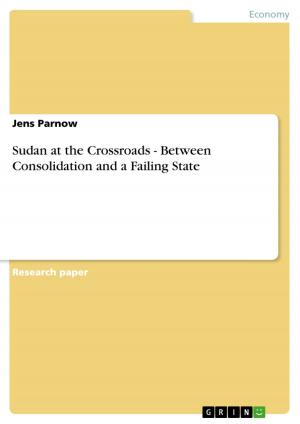Chinese Foreign Direct Investments - Scopes, Forms and Motives
Scopes, Forms and Motives
Business & Finance, Management & Leadership, Management| Author: | Carolina Sohn, Brigitte Stark, Michel Heck | ISBN: | 9783638475945 |
| Publisher: | GRIN Publishing | Publication: | March 6, 2006 |
| Imprint: | GRIN Publishing | Language: | English |
| Author: | Carolina Sohn, Brigitte Stark, Michel Heck |
| ISBN: | 9783638475945 |
| Publisher: | GRIN Publishing |
| Publication: | March 6, 2006 |
| Imprint: | GRIN Publishing |
| Language: | English |
Essay from the year 2005 in the subject Business economics - Business Management, Corporate Governance, grade: 1,3, Munich Business School University of Applied Sciences, 19 entries in the bibliography, language: English, abstract: Introduction Since the initiation of economic reforms in 1979, China has become one of the world's fastest-growing economies. From 1979 to 2004 China's real GDP grew at an average rate of 9.3 %1 and many economists speculate that China could become the world's largest economy at some point in the near future if the government continues and deepens its economic reforms. Moreover, trade continues to play a major role in China's booming economy. In 2004, exports accounted for US$ 593 billion and imports for US$ 561 billion which makes China the third-largest trading economy worldwide.2 China's trade boom is largely due to the inflow of foreign direct investment (FDI). Most people know that China is a magnet for FDI and that it attracts more than any other country. In 2003 mainland China surpassed the United States as the largest FDI recipient. One year later the FDI inflow reached US$ 61 billion3 resulting in a cumulative level of FDI of US$ 563 billion4 at the end of 2004. Looking at these figures and at the 'China fever' of managers from all over the world it is not very astonishing that for the last five years at least the big story has been about China's FDI inflows. But there is another story as well. It is hardly mentioned in the press but it is becoming more and more important: the increase of Chinese FDI outflows. For this reason the essay on hand shows, based on a general definition of FDI, the scope of China's FDI outflows through current data and categorizes the different forms of FDI. Furthermore, the motives of Chinese companies investing abroad as well as the governmental actions supporting the going global movement are analysed. Then Chinese FDIs are examined in great detail at the example of Germany. Finally, problems of the development are discussed and the essay concludes with an outlook about China's future FDI outflows. --- 1 cf. Morrison, Wayne M. (2005): China's Economic Conditions, http://www.fas.org/sgp/crs/row/IB98014.pdf, 24.10.2005. 2 cf. ibidem. 3 cf. UNCTAD (2005): World Investment Report 2005, http://unctad.org-wir05_fs_cn_en.pdf, 13.10.2005. 4 cf. Morrison, Wayne M. (2005), 24.10.2005.
Essay from the year 2005 in the subject Business economics - Business Management, Corporate Governance, grade: 1,3, Munich Business School University of Applied Sciences, 19 entries in the bibliography, language: English, abstract: Introduction Since the initiation of economic reforms in 1979, China has become one of the world's fastest-growing economies. From 1979 to 2004 China's real GDP grew at an average rate of 9.3 %1 and many economists speculate that China could become the world's largest economy at some point in the near future if the government continues and deepens its economic reforms. Moreover, trade continues to play a major role in China's booming economy. In 2004, exports accounted for US$ 593 billion and imports for US$ 561 billion which makes China the third-largest trading economy worldwide.2 China's trade boom is largely due to the inflow of foreign direct investment (FDI). Most people know that China is a magnet for FDI and that it attracts more than any other country. In 2003 mainland China surpassed the United States as the largest FDI recipient. One year later the FDI inflow reached US$ 61 billion3 resulting in a cumulative level of FDI of US$ 563 billion4 at the end of 2004. Looking at these figures and at the 'China fever' of managers from all over the world it is not very astonishing that for the last five years at least the big story has been about China's FDI inflows. But there is another story as well. It is hardly mentioned in the press but it is becoming more and more important: the increase of Chinese FDI outflows. For this reason the essay on hand shows, based on a general definition of FDI, the scope of China's FDI outflows through current data and categorizes the different forms of FDI. Furthermore, the motives of Chinese companies investing abroad as well as the governmental actions supporting the going global movement are analysed. Then Chinese FDIs are examined in great detail at the example of Germany. Finally, problems of the development are discussed and the essay concludes with an outlook about China's future FDI outflows. --- 1 cf. Morrison, Wayne M. (2005): China's Economic Conditions, http://www.fas.org/sgp/crs/row/IB98014.pdf, 24.10.2005. 2 cf. ibidem. 3 cf. UNCTAD (2005): World Investment Report 2005, http://unctad.org-wir05_fs_cn_en.pdf, 13.10.2005. 4 cf. Morrison, Wayne M. (2005), 24.10.2005.















